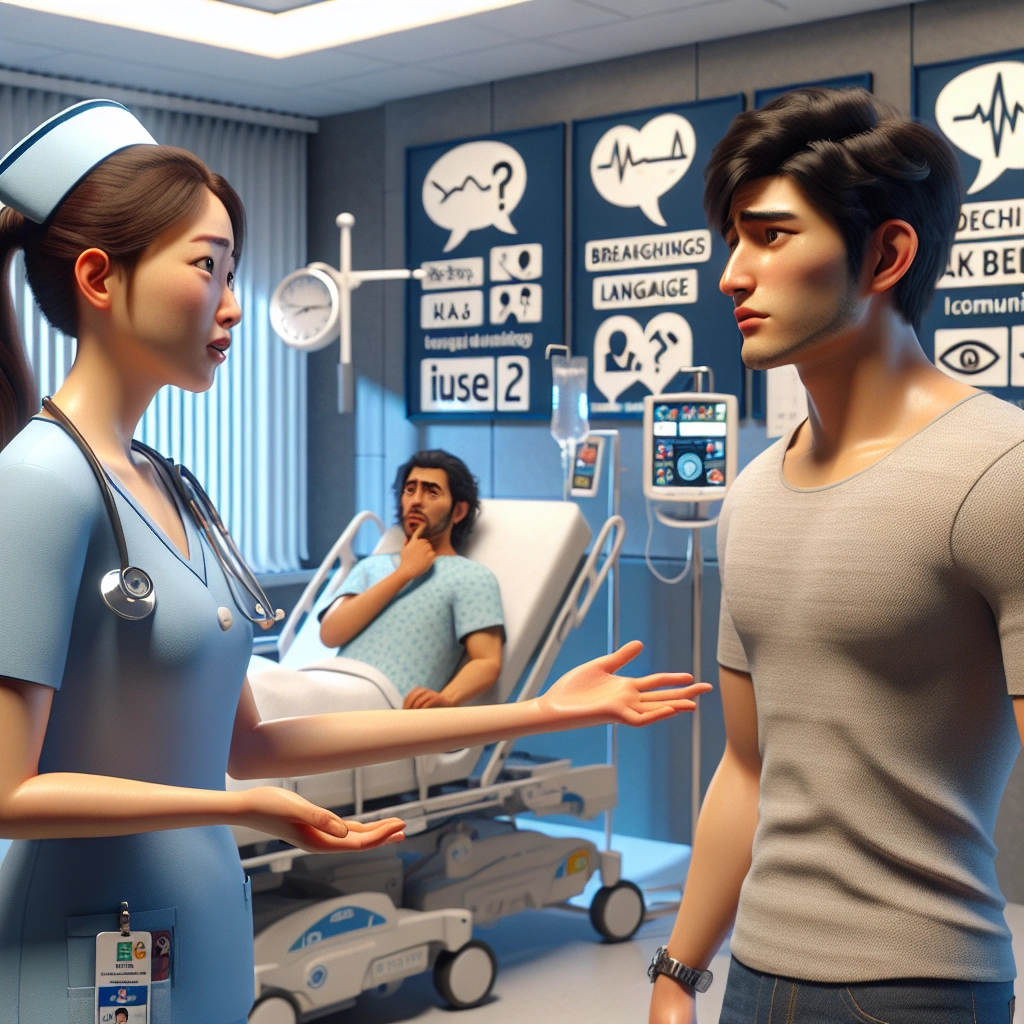

Language barriers between nurses and patients can significantly impact the quality of healthcare provided. It can lead to misunderstandings, miscommunication, and ultimately compromise patient safety.
Addressing these language barriers is crucial for improving patient outcomes and ensuring effective healthcare delivery.
In this blog post, we will explore the challenges posed by language barriers between nurses and patients, as well as the potential solutions and strategies for effective communication. Understanding the impact of language barriers in healthcare settings is essential for all healthcare professionals, and this post aims to provide valuable insights and best practices for addressing these challenges.
Stay tuned for practical tips and recommendations on overcoming language barriers to enhance patient care.
Check out this Youtube video: “Nursing students face language barrier obstacle” and gain valuable insight into the challenges faced by nurses when communicating with patients from different language backgrounds.
The Importance of Effective Communication in Healthcare
Effective communication is integral in healthcare, bridging the gap between nurses and patients. When there are language barriers between nurses and patients, it can lead to adverse events and increased healthcare services consumption.
These barriers indirectly impact patient care, reducing both patient and medical provider satisfaction, and hindering effective communication between medical providers and patients.
Factors Contributing to Language Barriers Between Nurses and Patients
Diversity in patient population
The diverse backgrounds of patients in healthcare settings create language barriers due to differences in languages spoken, cultural norms, and healthcare beliefs. This diversity necessitates the need for a wide array of interpretation services and multilingual healthcare professionals to effectively communicate with patients from various cultural and linguistic backgrounds.
Limited resources for interpretation services
Inadequate access to professional interpretation services, including trained medical interpreters and technology-based interpreter services, contributes significantly to language barriers between nurses and patients. This scarcity of resources hinders effective communication and compromises the quality of healthcare delivery to linguistically diverse patient populations.
Understanding the Challenges Faced by Nurses in Overcoming Language Barriers
Lack of language training for healthcare professionals
The lack of comprehensive language training for healthcare professionals creates significant challenges in effectively communicating with patients who have limited English proficiency. Multicultural competencies training programs have been identified as a valuable resource in addressing this issue. These programs equip healthcare staff with the necessary skills to communicate effectively with diverse patient populations, ultimately improving patient outcomes and satisfaction.
Time constraints in a busy healthcare environment
In a fast-paced healthcare environment, nurses often face time constraints that restrict their ability to effectively address the communication needs of patients with language barriers. Increased workload and limited time may lead to reduced quality of nurse-patient communication, impacting patient care and satisfaction. Strategies for overcoming language barriers, such as the use of interpreters and prioritizing bilingual staffing, are essential in mitigating the impact of time constraints on nurse-patient communication.
The Impact of Language Barriers on Patient Outcomes
Misunderstandings leading to medical errors
Language barriers between nurses and patients can lead to serious misunderstandings, resulting in medical errors. Miscommunication due to language disparities can hinder the accurate exchange of crucial medical information, potentially leading to misdiagnoses or incorrect treatment plans.
Increased patient dissatisfaction and disengagement
Additionally, language barriers contribute to increased patient dissatisfaction and disengagement. Patients may feel frustrated and disengaged when they are unable to effectively communicate their symptoms, concerns, and medical history to their healthcare providers.
This lack of engagement can impact the overall quality of care and patient-provider relationships.
Strategies for Overcoming Language Barriers Between Nurses and Patients
Utilizing professional interpretation services
Professional interpretation services, such as those provided by trained and certified medical interpreters, play a critical role in bridging the language gap between nurses and patients. These professionals ensure accurate and culturally sensitive communication, leading to improved patient comprehension, satisfaction, and overall healthcare outcomes.
Their expertise minimizes the risk of communication errors and enhances the quality of care provided to linguistically diverse patient populations.
Implementing language training programs for healthcare staff
Equipping healthcare staff, including nurses, with language training programs can significantly enhance their ability to communicate effectively with patients from diverse linguistic backgrounds. Such programs empower healthcare professionals to develop essential language skills and cultural competency, fostering meaningful and empathetic interactions with patients.
By investing in ongoing language training initiatives, healthcare facilities can bolster their staff’s ability to deliver patient-centered care and address the challenges posed by language barriers.
Training and Education for Nurses to Address Language Barriers
Cultural competence training for nurses involves equipping them with the knowledge, skills, and attitudes necessary to provide quality care to patients from diverse cultural backgrounds.
It includes understanding and respecting cultural differences, communication styles, and healthcare beliefs of patients to ensure effective interactions and improved patient outcomes.
Cultural competence training
Nurses undergo training programs that emphasize the importance of cultural sensitivity in care delivery and equip them with strategies to navigate language and cultural barriers effectively.
Language proficiency assessments for nurses
These assessments evaluate nurses’ language proficiency in reading, writing, listening, and speaking, ensuring they possess the necessary linguistic skills to communicate effectively with patients from diverse linguistic backgrounds.
| Language Competency Test | Description |
|---|---|
| Cambridge English (B2 First, C1 Advanced, or C2 Proficiency exams) | Assesses different levels of English proficiency |
| TOEFL iBT (Test of English as a Foreign Language, Internet-based Test) | Measures English language skills for non-native English speakers |
| TOEIC (Test of English for International Communication) | Evaluates English proficiency in an international business environment |
| IELTS (International English Language Testing System) | Tests the English language proficiency for study, work, and migration |
Language proficiency assessments ensure that nurses can effectively communicate with patients who have limited English proficiency, ultimately improving the quality and safety of patient care.
Implementing Technology Solutions to Bridge Language Gaps
Incorporating technology solutions such as translation apps and devices can significantly reduce language barriers between nurses and patients in healthcare settings. These tools provide real-time language translation, enabling seamless communication between healthcare professionals and non-English-speaking patients.
Use of translation apps and devices
The utilization of translation apps and devices, such as DeepL Translator and Google Translate, empowers healthcare providers to overcome linguistic obstacles and effectively convey crucial medical information to patients with limited English proficiency. These apps offer features like voice recognition, text-to-speech support, and offline capabilities, ensuring uninterrupted communication even in remote or offline settings.
Telemedicine for remote interpretation services
Telemedicine facilitates remote interpretation services, allowing healthcare professionals to access on-demand interpreters seamlessly. Video remote interpreting (VRI) provides the highest level of accuracy, integrating interpreters into telehealth systems for real-time medical consultations.
Such technologies bridge the language gap, ensuring that non-English-speaking patients receive adequate and comprehensible healthcare services.
| Translation App/Device | Key Features |
|---|---|
| DeepL Translator | Language variety, voice recognition, text-to-speech support, offline capabilities |
| Google Translate | Real-time translation, voice input, text translation, offline accessibility |
Creating a Multilingual Environment in Healthcare Settings
Utilizing multilingual signage and communication materials
The use of multilingual signage and communication materials is crucial in healthcare settings to bridge the gap created by language barriers between nurses and patients. By providing information in multiple languages, hospitals can ensure that patients with limited English proficiency can understand vital instructions and navigate the healthcare system effectively.
Hiring staff with diverse language skills
Hiring staff members with diverse language skills is a proactive approach to addressing language barriers between nurses and patients. Having multilingual healthcare professionals on the team enables seamless communication and fosters a supportive environment where patients feel understood and cared for, regardless of their primary language.
The Ethical Considerations of Language Barriers in Healthcare
Ensuring patient confidentiality during interpretation:
– Patient confidentiality is of utmost importance during interpretation, requiring healthcare personnel to maintain a secure and private environment for all patient interactions.
– Medical interpreters should strive to create a calm and comfortable atmosphere, preventing confidential discussions from being overheard in public areas and obtaining patient permission before involving additional staff.
Respecting patient autonomy and preferences:
– Respecting patient autonomy and preferences is crucial, particularly when language and cultural barriers hinder effective communication between healthcare providers and patients.
– Clinicians should prioritize patient-centered care and respect patients’ cultural, religious, and social norms while navigating the practical challenges of decision-making capacity and health literacy.
Case Studies: Effective Communication Despite Language Barriers
Effective communication between nurses and patients despite language barriers is a crucial aspect of healthcare. These success stories highlight the triumph of human connection over linguistic challenges.
Success stories of nurses and patients overcoming language barriers
One remarkable success story involves a nurse who learned basic phrases in her patient’s language, such as greetings and medical terms, to facilitate simple yet essential communication. This effort not only comforted the patient but also significantly improved the overall care experience.
Another inspiring tale features a patient who, despite language differences, found comfort and trust in a nurse’s compassionate demeanor and body language. This emotional connection transcended words and fostered a deep sense of understanding and support.
A striking case study emphasizes the power of using visual aids and technology to bridge language gaps. By incorporating images, diagrams, and translation apps, nurses successfully communicated crucial medical information to non-English-speaking patients, greatly enhancing the quality of care.
Lessons learned from challenging communication scenarios
These stories underscore the importance of empathy, creativity, and flexibility in overcoming language barriers. They highlight the significance of non-verbal communication, the willingness to learn basic phrases, and the integration of visual tools in establishing effective nurse-patient rapport.
| Nurse-Patient Communication Success Stories |
|---|
| Nurse’s Effort to Learn Patient’s Language |
| Patient-Nurse Emotional Connection |
| Innovative Use of Visual Aids and Technology |
The Role of Healthcare Policies in Addressing Language Barriers
Legislative requirements for interpretation services
The legislative requirements for interpretation services emphasize the provision of qualified interpreters for limited English proficiency (LEP) patients. Under Title VI of the Civil Rights Act and Executive Order 13166, healthcare organizations receiving federal assistance are obliged to offer interpreter services to LEP individuals.
Additionally, Section 1557 of the Affordable Care Act mandates that any healthcare provider receiving federal assistance must provide LEP patients with a qualified interpreter.
Healthcare facility language access plans
Healthcare facility language access plans play a crucial role in ensuring effective communication with non-English-speaking patients. These plans involve a comprehensive assessment of the language preferences and communication challenges of patients, followed by the development of strategies to provide multilingual services.
By outlining these plans, healthcare facilities can effectively bridge the language barriers between nurses and patients.
| Key Points | Details |
|---|---|
| Legislative requirements | – Title VI of the Civil Rights Act and Executive Order 13166 mandate interpreter services- Section 1557 of the Affordable Care Act necessitates a qualified interpreter for LEP patients |
| Healthcare facility language access plans | – Assess language preferences and communication challenges- Provide comprehensive multilingual services |
Remember, when it comes to healthcare policies addressing language barriers, it’s important to adhere to these legislative requirements and develop effective language access plans to ensure quality care for all patients, regardless of their language proficiency.
Collaborating with Community Resources to Support Multilingual Patients
Partnerships with community organizations
- To bridge the language barriers between nurses and patients, it is crucial to establish strong partnerships with community organizations. These partnerships can provide valuable insights into the specific linguistic needs of the local population, enabling healthcare providers to tailor their services accordingly.
Engaging language-specific support groups
- Engaging with language-specific support groups is an effective way to address language barriers in healthcare settings. By collaborating with these groups, nurses can gain a better understanding of the cultural nuances and language preferences of their patients, thus improving communication and ultimately enhancing the quality of care.
The Impact of Effective Communication on Patient Satisfaction and Trust
Effective communication between nurses and patients plays a crucial role in building rapport and trust. When nurses effectively communicate with patients, it helps in establishing a strong rapport, creating a trusting relationship, and ultimately leading to higher levels of patient satisfaction.
This communication allows patients to feel heard, understood, and valued, resulting in a positive impact on their overall healthcare experience.
Improving patient engagement and adherence to treatment plans is heavily reliant on effective communication. When nurses effectively communicate with patients, it leads to higher levels of patient engagement in their care and better adherence to treatment plans.
Clear and concise communication helps patients understand their treatment plans, leading to increased compliance and better health outcomes.
| Impact of Effective Communication | |
|---|---|
| Building Rapport and Trust | Improved patient satisfaction |
| Improved Patient Engagement | Adherence to treatment plans |
| The importance of trust | Improved patient outcomes |
Effective communication between nurses and patients is not just about conveying information; it’s about building relationships, fostering trust, and ultimately improving patient satisfaction and adherence to treatment plans. The impact of effective communication cannot be underestimated in enhancing the overall patient experience and fostering better healthcare outcomes.
In conclusion, effective communication between nurses and patients has a significant impact on patient satisfaction and trust, as well as patient engagement and adherence to treatment plans. It forms the foundation of a strong nurse-patient relationship, leading to improved healthcare outcomes and a positive patient experience.
The Financial and Operational Benefits of Addressing Language Barriers
Cost savings from reducing medical errors
By addressing language barriers between nurses and patients, a significant reduction in medical errors can be achieved, leading to considerable cost savings. Studies have shown that effective communication can prevent a large number of preventable adverse events, resulting in an estimated annual cost savings of $6.8 billion.
Streamlining communication processes in healthcare settings
Addressing language barriers streamlines communication processes in healthcare settings, leading to improved patient-provider interactions and enhanced healthcare quality. This can result in higher patient satisfaction, better treatment adherence, and overall operational efficiency within healthcare facilities.
Measuring the Effectiveness of Communication Strategies in Healthcare
For quality improvement initiatives, measuring the effectiveness of communication strategies in healthcare involves assessing the impact of these strategies on patient outcomes, satisfaction levels, and overall quality of care. It requires analyzing the success of implementing language interpretation services, cultural competency training for healthcare staff, and the use of visual aids to promote effective communication.
Effective strategies should lead to improved patient understanding, reduced medical errors, and enhanced patient-clinician relationships.
When it comes to patient feedback and satisfaction surveys, it is essential to include specific questions related to language barriers between nurses and patients. Feedback should focus on the clarity of communication, ease of understanding medical information, and overall satisfaction with the level of language support provided.
Additionally, such surveys should address the impact of language barriers on the patient experience and identify areas for improvement, such as increased access to interpreter services and culturally sensitive communication training for nurses.
| Survey Question | Example Response |
|---|---|
| How satisfied are you with the language support provided during your medical care? | Very Satisfied |
| Did you encounter any difficulties understanding medical information due to language barriers? | Yes |
| What improvements would you suggest to enhance communication with non-English speaking patients? | More access to in-person interpreters |
Recommended Amazon Products for Improving Communication Between Nurses and Patients
Here’s a curated list of products that can help nurses overcome language barriers and communicate effectively with patients. These recommendations are based on functionality, price, and customer reviews.
Professional Voice Translation Device


A professional voice translation device can help nurses and patients bridge the gap in language barriers. It offers real-time translation of conversations, allowing for effective communication in healthcare settings.
Multilingual Communication Cards


These multilingual communication cards provide visual aids for patients and nurses to overcome language barriers. The cards display common healthcare phrases in multiple languages, improving communication and understanding.
Language Interpretation Services Subscription


Subscribing to a language interpretation service can provide nurses with on-demand access to professional interpreters in various languages. This service ensures accurate and reliable communication with multilingual patients.
Portable Language Translation Device


A portable language translation device offers convenience and ease of use for nurses interacting with patients who speak different languages. It provides instant translation of spoken words, contributing to effective communication.
Multilingual Medical Terminology Guidebook


A multilingual medical terminology guidebook can serve as a valuable reference for nurses encountering language barriers. It offers translations of essential medical terms in multiple languages, aiding communication with patients.
Pros and Cons of Recommended Products
| Product | Pros | Cons |
|---|---|---|
| Professional Voice Translation Device | Real-time translation, Easy to use | High upfront cost |
| Multilingual Communication Cards | Visual aid for communication, Affordable | Limited phrases available |
| Language Interpretation Services Subscription | Professional interpreters, Wide language coverage | Ongoing subscription fees |
| Portable Language Translation Device | Convenience, Instant translation | Limited language support |
| Multilingual Medical Terminology Guidebook | Valuable reference, Multiple language translations | Reliance on manual lookup |
Top Recommended Product for Improving Communication Between Nurses and Patients
If you’re looking for the best solution for improving communication between nurses and patients, we highly recommend the Professional Voice Translation Device. This device offers real-time translation and ease of use, making it a valuable tool for overcoming language barriers in healthcare settings. Ready to improve your communication with patients? Check out the Professional Voice Translation Device today for the best results!


Conclusion
The research has shown that the impact of social media on mental health is significant, with findings indicating a correlation between excessive social media use and increased rates of anxiety and depression. Furthermore, the influence of social media on body image and self-esteem was also found to be a contributing factor to mental health issues among users.
The implications of these findings underscore the importance of promoting healthy social media habits and fostering a supportive online environment for individuals.
The research highlights the need for further exploration and understanding of the complex relationship between social media and mental health. It is crucial for mental health professionals, policymakers, and social media platforms to collaborate in developing strategies and interventions to mitigate the negative effects of social media on mental well-being.
By addressing these issues, we can work towards creating a healthier and more positive online environment for individuals to engage in, ultimately promoting mental wellness and resilience in the digital age.
The findings from this research emphasize the necessity of promoting digital literacy and mindfulness in social media use to protect individuals’ mental health. By raising awareness and implementing targeted interventions, we can strive towards a more balanced and positive relationship between social media and mental well-being, ultimately creating a more supportive and uplifting online community for all users.


















